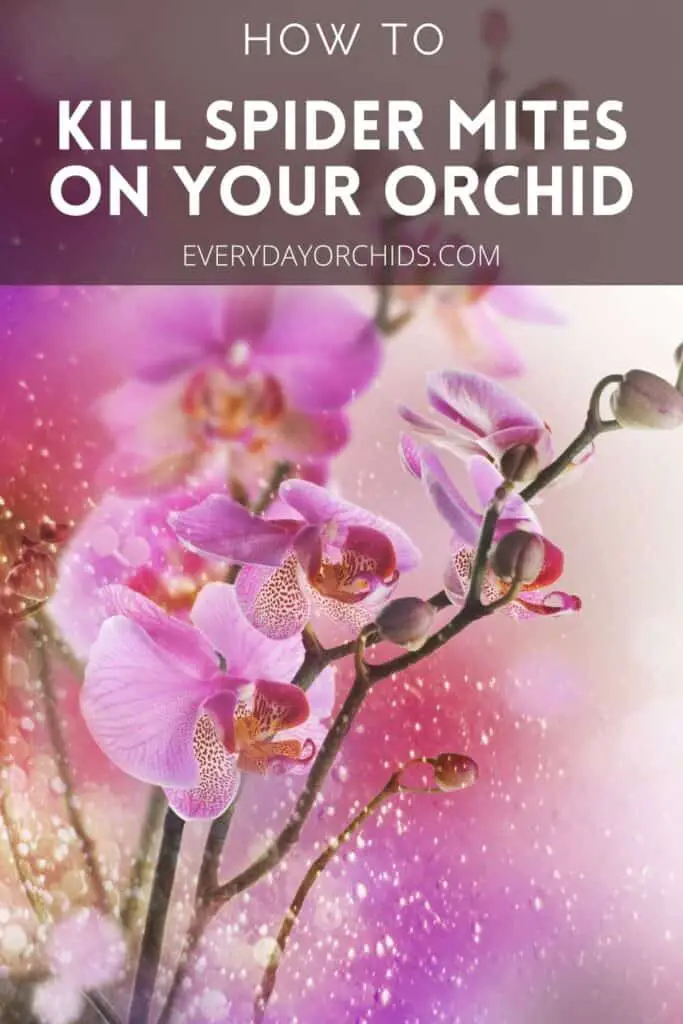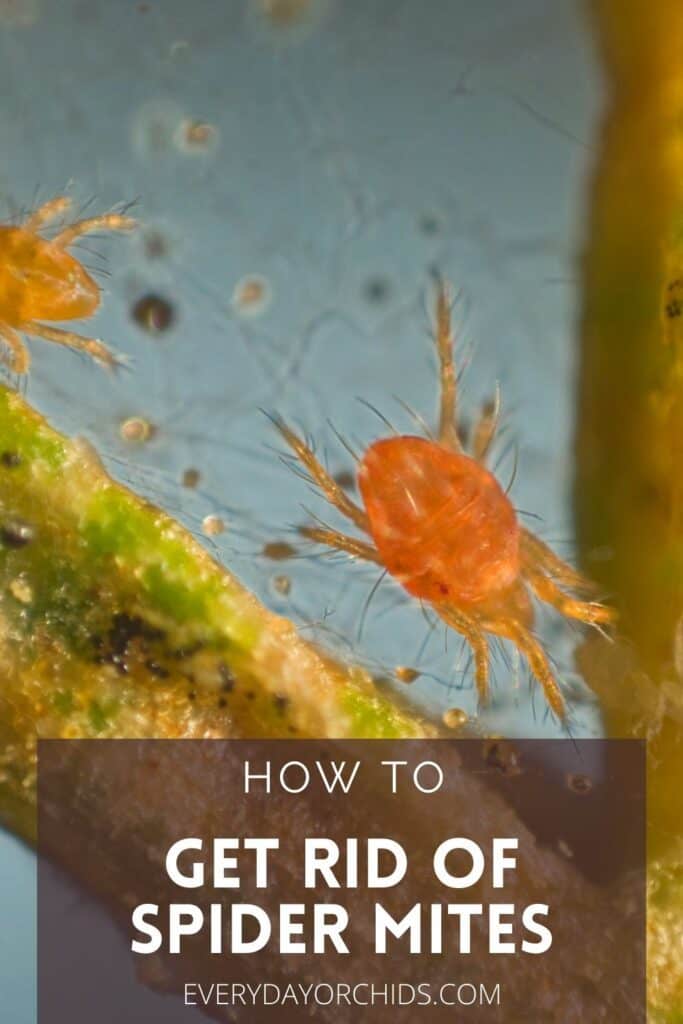Do you have spider mites on your orchid? You might, and might not even know it.
If you’ve noticed fine, thin, spider webbing on your orchid leaves, pseudobulbs, roots or flower spikes, you might think this is the work of a spider. Close, but not quite.
These webs are actually made by spider mites, a common orchid pest. Left to their own devices, spider mites will quickly spread and infest your entire orchid collection. Here’s how to stop them in their tracks.
To get rid of spider mites in your orchids, use a miticide, predatory mites or horticultural oils such as Neem oil. Regular inspection of your orchids and early interventions can help keep the spider mite infestation from taking over and killing your orchid.
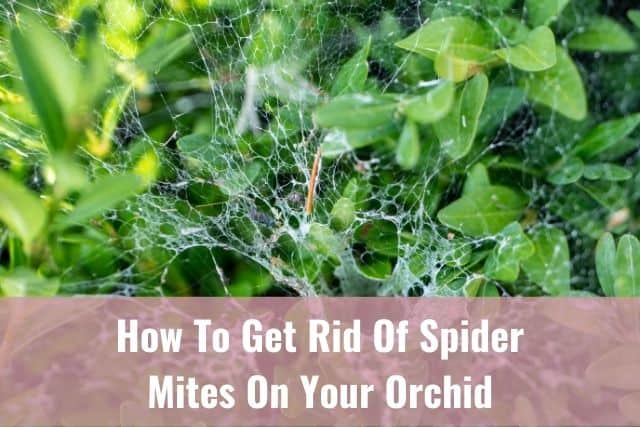
If you have spider mites on your orchid and want to learn more, you’ve come to the right place.
I’ll go over how to tell if your orchid has spider mites, what growing conditions can encourage or discourage spider mite growth, and how to prevent these pests. Most importantly, I’ll tell you how to get rid of spider mites on your orchid. Keep reading to learn more.
Please note that these links are affiliate links and as an Amazon Associate, I earn from qualifying purchases. Purchases made through affiliate links in this post may generate commissions at no additional cost to you. Use this link for a discounted Amazon Prime trial. Thank you for your support!
Table of Contents
What Do Spider Mites Look Like On Orchids?
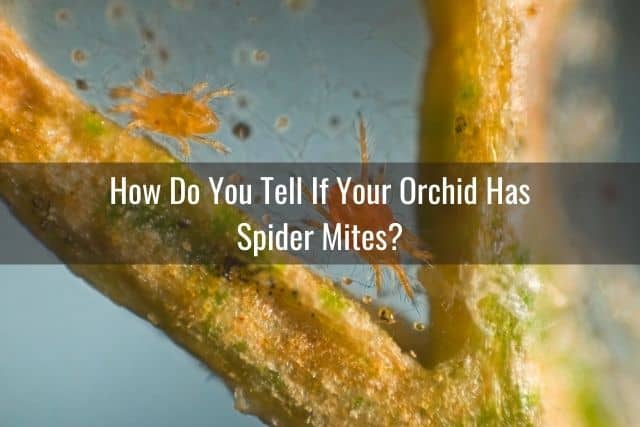
There are a variety of different spider mite species, including the red spider mite, false spider mites, and the two-spotted spider mite. Spider mites are related to ticks and spiders.
They are incredibly small and difficult to see without a magnifying glass. In fact, you may not know your orchid has spider mites until you see those tale-tell webs on your plant, which are unfortunately, a late sign of an infestation.
Here are some signs that your orchid may have spider mites:
- Tiny puncture holes or sunken pits on the top or underside of the orchid leaves. Leaves will look “pock-marked” or have tiny pin-hole marks.
- In some orchid species, such as Dendrobiums, the leaves may take on a silvery or gray sheen due to the death of superficial plant cells.
- Fine webbing between leaves, roots, along the top of the potting media, or on the flower spikes between the buds.
- Fine webbing on the underside of the leaves, making the underside of the leaves appear pale.
- Brown or black marks on the leaves. This is usually due to a secondary fungal or bacterial infection that has hit your orchid, due to its weakened state.
Spider mites like to hide out on the underside of leaves, as well as on the lower, older leaves of orchids. They move slowly and may remain on that same leaf for their whole lives.
Unlike mealybugs and fungus gnats, whose larger size and movements make them more apparent, spider mites are small and slow, making them easy to miss.
How To Check If Your Orchid Has Spider Mites
If you aren’t sure if your orchid has spider mites or not, check for the tale-tell signs I listed above.
In addition, you can take a soft, white cloth and wipe down the undersides of your orchid leaves. If your orchid has spider mites, you will see a reddish-brown stain on the cloth.
Alternatively, you can hold a white paper under your orchid leaf and tap the leaf. If any small, brownish or reddish specks fall onto the paper, you likely have spider mites on your orchid.
Spider mites are attracted to dry, low humidity, low light conditions. In other words, if you want to try to deter these pests from infesting your orchids, do your best to avoid these growing conditions. Make sure your orchid has adequate humidity and light.
What Growing Conditions Attract Spider Mites?

Warm, dry conditions will cause the life cycles of spider mites to be shorter. Temperatures above 80 degrees Fahrenheit are generally accompanied by low humidity. This combination sets up the optimal growing conditions for spider mites. This is bad news for the orchid grower.
The faster that spider mites progress through their life cycle, the faster a new batch of eggs will be laid, and the spider mite population can grow quickly in a relatively short amount of time.
How Did My Orchid Get Spider Mites?
Unfortunately, spider mites are fairly common pests, not just for orchids, but for many houseplants and outdoor plants as well. They are carried from plant to plant by air currents, pets, contaminated potting media, clothes, hands, and so on.
Orchids that are in close proximity, such as those in the grocery store, orchid shows, or orchid warehouses, can easily pick up spider mites from infected orchids.
In fact, mites may be present on your orchid and you may not know it. They won’t show themselves until dry, low humidity conditions are present. Then at that time, the spider mite population will take off.
Spider mites are plentiful in the outdoor environment. If you grow your orchids outdoors, be on the lookout for these pests.
If your orchids are only outdoors during the warmer weather in spring and summer, you will want to isolate the orchids for at least two weeks before moving them indoors. As part of your fall orchid care, check over your orchids for any pests or diseases and deal with any issues before bringing them inside your house.
Oftentimes, spider mites won’t make an appearance immediately. You may only notice them once the population grows to a certain point or when the weather conditions are ideal.
How Do Spider Mites Harm Orchids?
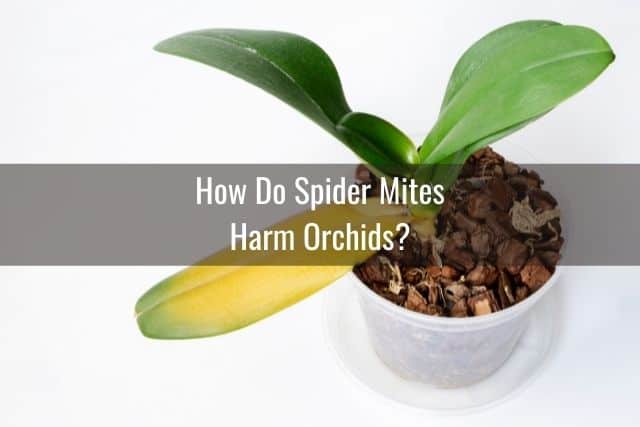
Spider mites can cause serious damage to your orchid in a short amount of time. Their mouths are able to puncture the orchid leaves and suck out the sap and nutrients from the leaves. These pests like to hide on the underside of leaves, so you may not notice them right away.
The leaf will collapse where the spider mite has sucked out the sap, leaving little tiny pits. As the mites continue to feast on the orchid leaves, you will see the leaves start to turn yellow.
In serious, untreated infestations, the damage can be severe. Necrotic spots will appear on the orchid leaves. When this happens, the plant tissue has died in those spots and this damage is irreversible.
In particular, spider mites can be a major problem for thin-leaf orchids, such as Oncidium orchids, Miltoniopsis orchids, and Cymbidium orchids.
They can cause premature leaf drop and orchid flowers to fall off early. These pests can damage the orchid and over time, weaken it, leaving it more susceptible to other pests and diseases.
Life Cycle Of Spider Mites
If you are wondering how quickly a spider mite infestation can occur, all you need to do is look at their life cycle.
The life cycle of a spider mite can last anywhere from 5 to 20 days, depending on the humidity and temperature levels. As mentioned above, low humidity and high temperatures will shorten the life cycle, leading to an explosion in the population.
To start, the adult female spider mites will lay their eggs in the webs. It takes about 3 days for the eggs to hatch. From that point on, the larvae will grow and develop into nymphs. Nymphs will develop into adults.
An adult female only lives for 2 to 4 weeks before she dies. However, in that short span of time, she can lay hundreds of eggs. Those eggs will go on to hatch.
As the new female nymphs grow into adults, they will each lay hundreds of eggs as well, causing the population to grow exponentially. In just one month, you can go from a couple spider mites on your orchid plant to a serious infestation.
How Do You Get Rid Of Spider Mites On Orchids?
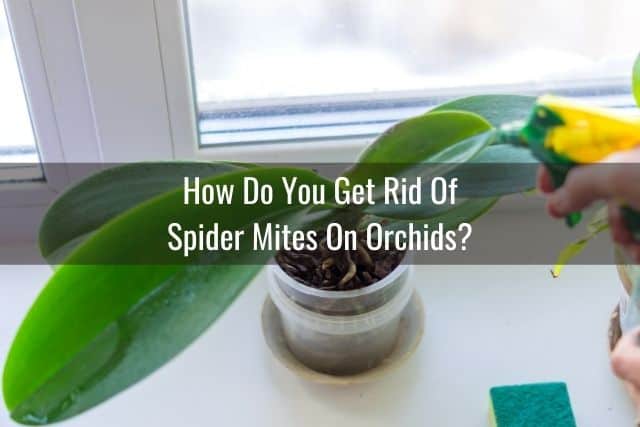
At the end of the day, a spider mite is a spider mite. The methods we will use to eradicate them from our orchids will essentially be the same no matter what species spider mite is attacking our plant.
You have a few options when dealing with a spider mite infestation. The most effective interventions include using miticides or predatory mites. Neem oil or other horticultural oils are also effective, but will likely need multiple applications. Rinsing off the infested areas is another option, but is also the least effective method. I will go into more detail about each option below.
Miticides For Orchids
Most insecticide treatments will not be effective against spider mites. This is because they are not considered insects, but are part of the mite family. You will need to use a miticide to kill spider mites.
When treating a spider mite infestation on your orchids, hit hard and fast. Kill as many as you can before they can reproduce and grow the population.
Spray a miticide treatment on your orchids in the spring and fall. This coincides with the time when spider mites are most active in their growth and reproduction. Apply a miticide treatment at most, just once or twice a season during the spring and fall months.
Note: Don’t apply a miticide more often than this because repeated applications of a miticide will allow the remaining mites to build up resistance to the miticide. As a result, future applications will be less effective, if at all.
When using miticide sprays, be sure you spray early in the morning, outdoors if possible. Avoid spraying your orchid during noontime or when the sun is at its hottest and brightest. Spraying your orchids at this time could inadvertently cause the orchid leaves to burn.
Spraying a miticide will kill off any nymphs or adult mites on the orchid. However, the miticide will not destroy the eggs.
In about a week, when the eggs have hatched, you will need to follow up with a second miticide spray. This will take care of any missed and recently hatched spider mites.
Be sure to spray the undersides of all the leaves, especially the older leaves and leaves closest to the potting media. Spray down the base of the orchid stem and the potting media, as spider mites often like to hide here.
Recommended Miticides
- Bonide makes a miticide spray called Mite-X, which can be used on indoor and outdoor plants.
- Natria makes an insecticidal soap spray which kills mites, aphids, mealybugs and other pests.
- AgroMagen makes a miticide, insecticide and pesticide product that can be used to kill spider mites, white flies, and other orchid pests on contact. This is an organic, natural pest control product you can safely use indoors.
Natural Predators
Most casual orchid growers will not use natural predators to deal with spider mites. However, if you have a large greenhouse or garden full of orchids, you may want to look into this natural method. It may be costly, but it is very effective.
Spider mites have several natural predators, which include ladybugs, wasps, and predatory mites. If you have a large outdoor orchid collection, live ladybugs are certainly an option you can look into. You can buy live ladybugs online.
For indoor and outdoor orchids, predatory mites are an incredibly effective way to deal with a spider mite infestation.
Unlike with miticides, Neem oil or other spider mite control options, you won’t miss killing any spider mites when you use predatory mites. Predatory mites do all the work for you.
Simply release the predatory mites into your orchid potting media and they will go after and eat any mites they find. This includes newly hatched mites. In a short time, predatory mites will effectively eliminate the spider mite population.
You can buy predatory mites online. If you have a heavy spider mite infestation and don’t have the time to deal with it, this can be a great option. Think of it as outsourcing the job or hiring someone to do the work for you.
If you do use predatory mites, avoid using any insecticides or miticides on your orchid. Using these other products will kill your predatory mites.
One other point to also be aware of is that predatory mites may leave your orchid pot after they are done eating the spider mites. They will do this in order to search for more food.
Neem Oil And Other Horticultural Oils
Neem oil is a natural and organic treatment option for dealing with spider mites. It works by smothering the mites so that they cannot move around.
To be effective, Neem oil will have to be applied liberally to all infected areas, making sure good coverage is obtained. You may need to repeat the Neem oil treatment once a week over the course of a month to make sure you kill all the spider mites.
It is safe to use Neem oil for repeated treatments because of how it works. It suffocates them and immobilizes them, causing their eventual death.
Spider mites will not build resistance to Neem oil so you don’t have to worry about this when reapplying Neem oil to your orchid.
If you are curious about learning more, read this guide on how to use Neem oil on orchids.
You can use other horticultural oils to kill spider mites. These work in the same manner as Neem oil. They kill spider mites by smothering them and preventing movement.
For example, Trifecta Crop Control makes a natural miticide product using mint, garlic, clove and thyme oils. This product is generally safe to use on orchids, but I would recommend testing the product on a small area first before you spray down the whole orchid. It also treats powdery mildew, botrytis and mold. This is a great option if you are looking for a natural miticide and an anti-fungal, anti-bacterial product without chemicals.
High-Pressure Washing
Rinsing off your orchid or using high-pressure water to get the spider mites off the orchid is another option. However, I put this last because it is one of the least effective methods for getting rid of spider mites. On the other hand, it is easy and free.
If your orchids can handle it, use a high pressure blast of water to rinse off the orchids. Do this early in the morning so that the orchid potting media will have a chance to dry before nightfall. If water accidentally gets into the orchid’s crown, use a paper towel to dry up the excess water in the crown to prevent crown rot.
When rinsing off the orchids, focus on the underside of the orchid leaves, where the mites typically hide. Rinse off any other areas where webs are visible.
How To Prevent Spider Mites From Reinfesting Your Orchids
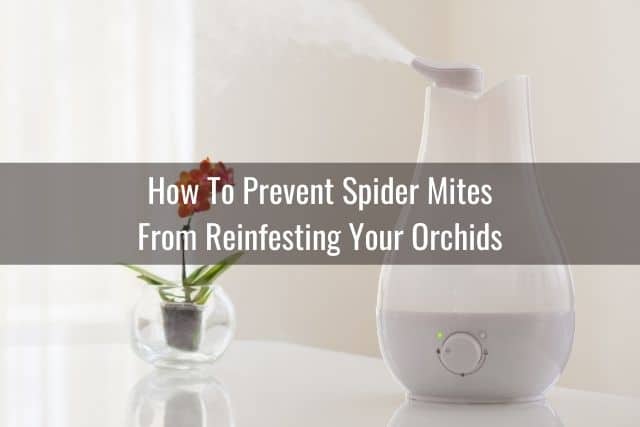
Moving forward, there are steps you can take to keep spider mites from coming back.
First and foremost, always inspect new orchids and other houseplants for pests and diseases before placing them with the rest of your collection. Generally, you want to isolate the new plant for at least two weeks and check it frequently for signs of pests and disease. Once you see something amiss, deal with it immediately.
Second, make sure you manage the temperature around your orchids. As you now know, spider mites thrive in dry, hot environments. Do your best to keep temperatures from getting too high. You may need to use a cooling fan near your orchids to keep the heat under control.
Third, maintain adequate humidity levels around your orchids. Most orchids prefer humidity levels between 40-80%, which is almost impossible to achieve without a humidifier, humidity tray or some other supplemental means.
Most homes have a humidity level of 30%, and this can drop even lower in the fall and winter. Use a hygrometer to keep an eye on the humidity levels around your orchids. Use a cool-mist humidifier or a humidity tray to increase humidity as needed.
Fourth, do some regular pruning. Spider mites love to hide in dead plant matter. As flower spikes and leaves die, remove these in a timely manner. Old, dead leaves could be harboring spider mite eggs, so you definitely don’t want to leave these sitting in your orchid potting media.
Last but not least, keep an eye on your orchids and inspect them regularly. As they say, an ounce of prevention is worth a pound of cure. Many orchid growers check over their orchids every day or every other day.
In addition to looking for new leaf and root growth, keep an eye out for the beginnings of a pest infestation, bacterial or fungal infection, and so on. The earlier you can spot the problem, the easier it will be to deal with it before it gets out of control.
Final Thoughts
Warm, dry, low humidity conditions encourage the proliferation of spider mites. Do your best to maintain humid conditions for your orchids and inspect your orchids regularly.
If you do find spider mites on your orchids, don’t panic. These are common orchid pests and there are a variety of methods you can use to deal with them.
The best and most effective ways to eliminate spider mites are miticides and predatory mites. This is followed by using Neem oil and rinsing off affected areas. Choose the method that works best for you and your orchids. Best of luck!
If you enjoyed this article, please pin it and share!
